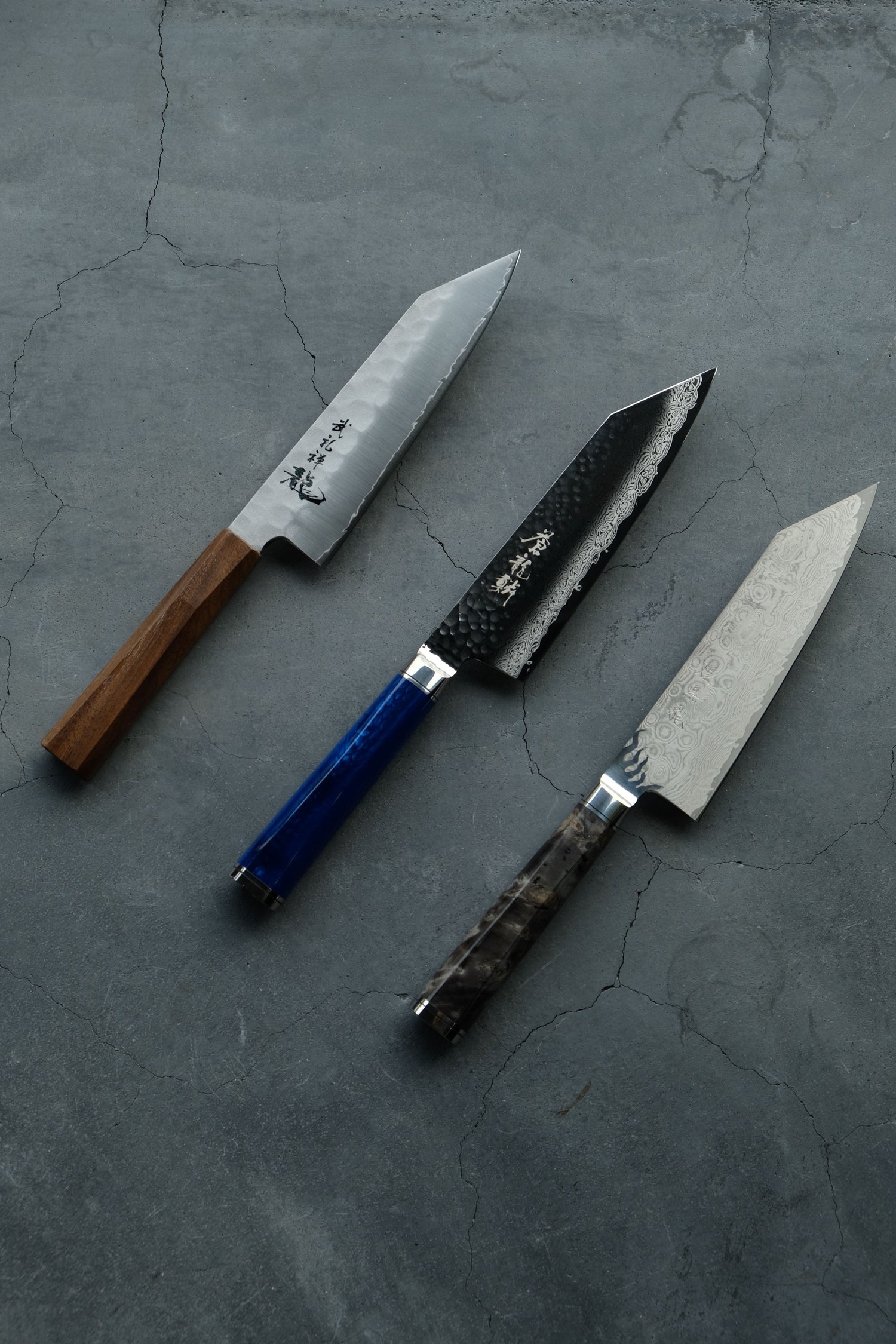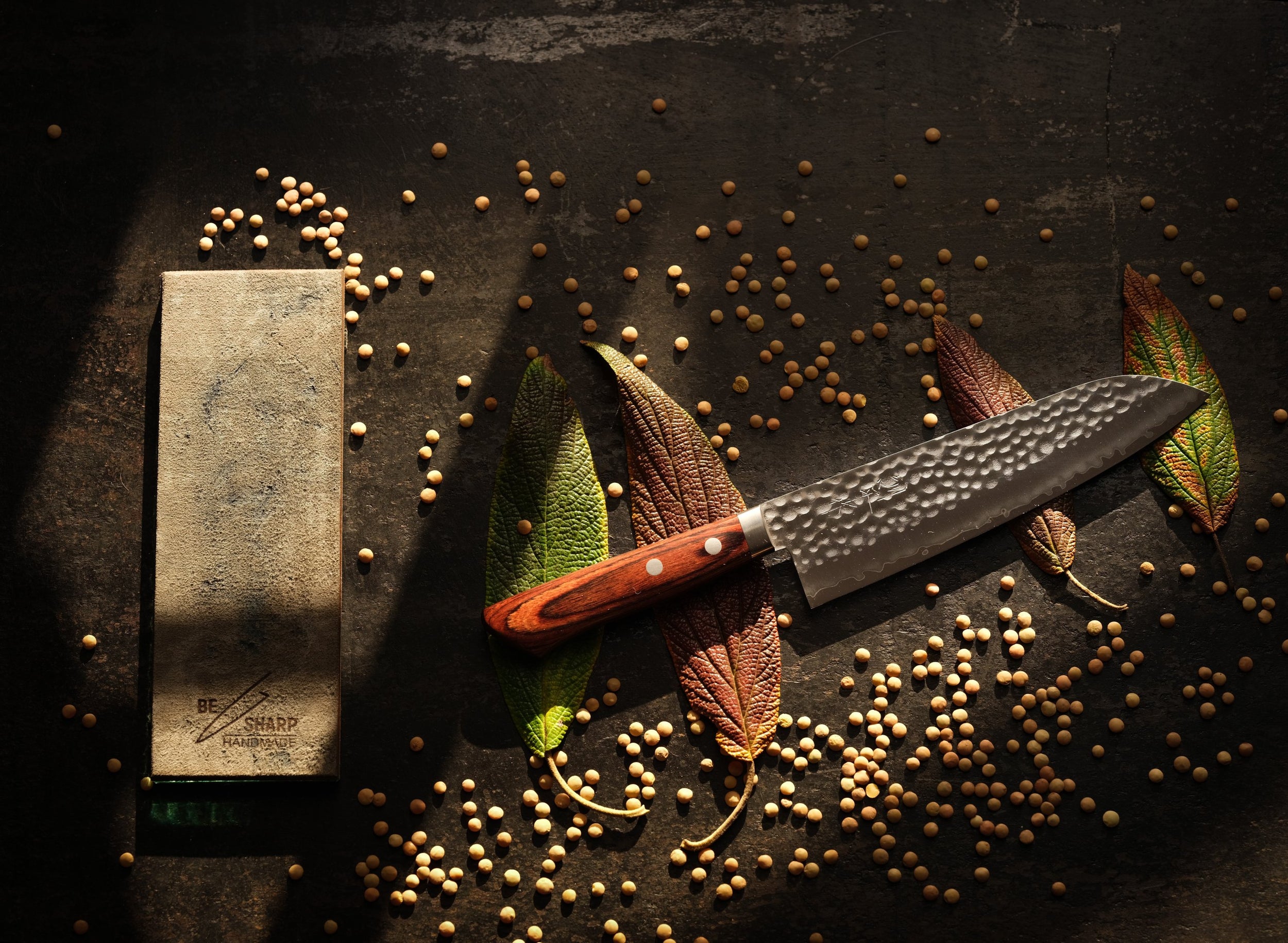How to choose the right knife for you?

Whether you are buying your first Japanese knife or adding to your collection, here are some guidelines to help you make the right choice.
First of all, of course, the question arises, which knife do you need? If you are buying your first Japanese knife, the advice is to choose a multifunctional blade shape that will cover the widest range of your needs in the kitchen. This includes Gyuto, Santoku and Bunka.
Speaking of the very first true Japanese knife, it should be your ticket to the world of Japanese blades. Therefore, we recommend that you go for a safer option and buy a blade that is incomparably better than the European ones but not completely delicate as the finest Japanese knives can be. You should look for a golden mean in terms of performance, appearance, and price. On this knife you can perfect the correct sharpening technique without any hard feelings, it will happily do almost any work in the kitchen you can imagine and it will be a good prelude to what is waiting for each of us - the next Japanese knife!
Price. The purchase of the first Japanese knife is considered by many to be an unnecessary allocation of money from the budget, and you must be wondering: "isn't that right?". Yes, you can buy yourself a regular, cheap knife from the grocery store that will cut the lemon in half when making lemonade. But buying a Japanese knife doesn't necessarily mean spending a huge amount of money. Knives that are produced in factories where highly trained workers work can almost always be found at affordable prices accessible to everyone. This is where the difference is made between a person who wants to enjoy what they prepare and a person who just wants their half of a lemon for lemonade.

This is probably the right time to draw your attention to the fact that a knife that is more expensive is not necessarily always better. For example, a Damascus blade will always be more expensive due to the complicated manufacturing process and more attractive appearance, but this does not affect how the knife cuts food. In this sense, even a cheaper blade can show better performance.
Blade size and knife balance are the next things to consider. It is definitely recommended that, if you have the opportunity, you first take each knife in your hand and check how it fits. That way, you can quickly and easily feel which knife is perfect for you. The rule is that larger knives are suitable for larger people and vice versa. If you are petite, the large 24cm Gyuto knife will certainly not suit you, as it is difficult to control. In that case, the right choice for you would be a knife of 18 cm or at most 21 cm, which again you can easily determine by holding the knife in your hand. If the knife is intended for the user, she will definitely want a smaller blade that she feels safer working with.

Of course, there are always small exceptions that only occur in 2% of cases. The aforementioned rule is applicable to almost the entire population.
The appearance of the knife is also an important item when buying. Whenever we have a situation where the customer is very hesitant between two knives of the same performance, this will be the deciding factor. You should always choose a knife that looks more attractive to you, and the reason is quite simple - with proper use and sharpening, a Japanese knife often becomes an heirloom that will be used by your children and then grandchildren. So once you buy it, it will stay with you for a long time and you should choose that blade that makes you feel awe every time you see it. If you compromise on this, sooner or later you'll find yourself regretting not choosing the blade that appealed to you more. What the Japanese would say: "Shoot once but shoot accurately".

Assembling a collection of Japanese knives. Once you step into the path of Japanese blades, you can hardly resist going forward. This also means upgrading your collection. If you are a professional boss, it is a smart decision to build the collection according to your current needs as well as the ones you expect. Let's say you've already bought your first Japanese knife and are now thinking about your next one. If you are at the beginning of your career, it is inevitable that you will get a lot of tasks that involve chopping vegetables. By purchasing a Nakiri knife, you will make your life easier in this period of advancement. The same applies if you are a vegetarian and love to cook at home, Nakiri is the right choice for you. Also a popular choice for a second or third Japanese knife is the Petty. Many decide to solve this issue at the very beginning of putting together a collection because there really is a daily need for this knife, especially if you work in a professional kitchen.
Let's say that you plan to start working in a good sushi restaurant and you want to focus your career on preparing Japanese cuisine. Traditional Japanese knives Yanagiba and Deba are the right choice for you. If you want to do things right from the beginning and want to appear in a professional style, after universal knives you will equip yourself with these narrowly specialized blades that will set you apart from the first day not only by the impression you will leave, but your dishes will look and taste superior to those who use ordinary knives, and this is easy to notice.

Once you are fully equipped with a tool that covers the basic needs of your work, there will come a time when you want to treat yourself to a prestigious Japanese knife that will be the highlight of your collection. Usually it will be a Bunka or Gyuto style of knife that you want to be special and unique to you. This is the time when it is worth "robbing the bank" and treating yourself to a completely hand-forged knife made by a recognized and respected blacksmith from Japan. They are more expensive, but definitely worth every penny. At first glance, you can see the enormous amount of work, experience, time, attention to detail and desire for the user to have something truly unique and special. These knives are considered the pinnacle of blade craftsmanship not only because of their looks but also because of their performance that exceeds everyone's expectations every time without exception.
To briefly summarize the compilation of the collection - the first knife for everyone should be a universal, Gyuto, Santoku or Bunka shape, followed by a Nakiri for preparing vegetables and a small Petty knife. After these basic shapes, continue with buying specific blades for your needs, like Yanagiba and Deba if you are a sushi master, Slicer and Boning knife or Honesuki if you process a lot of meat and so on. When the time is right, it's perfectly fine to treat yourself to a "state of the art" program of hand-forged knives by today's top and renowned blacksmiths.







